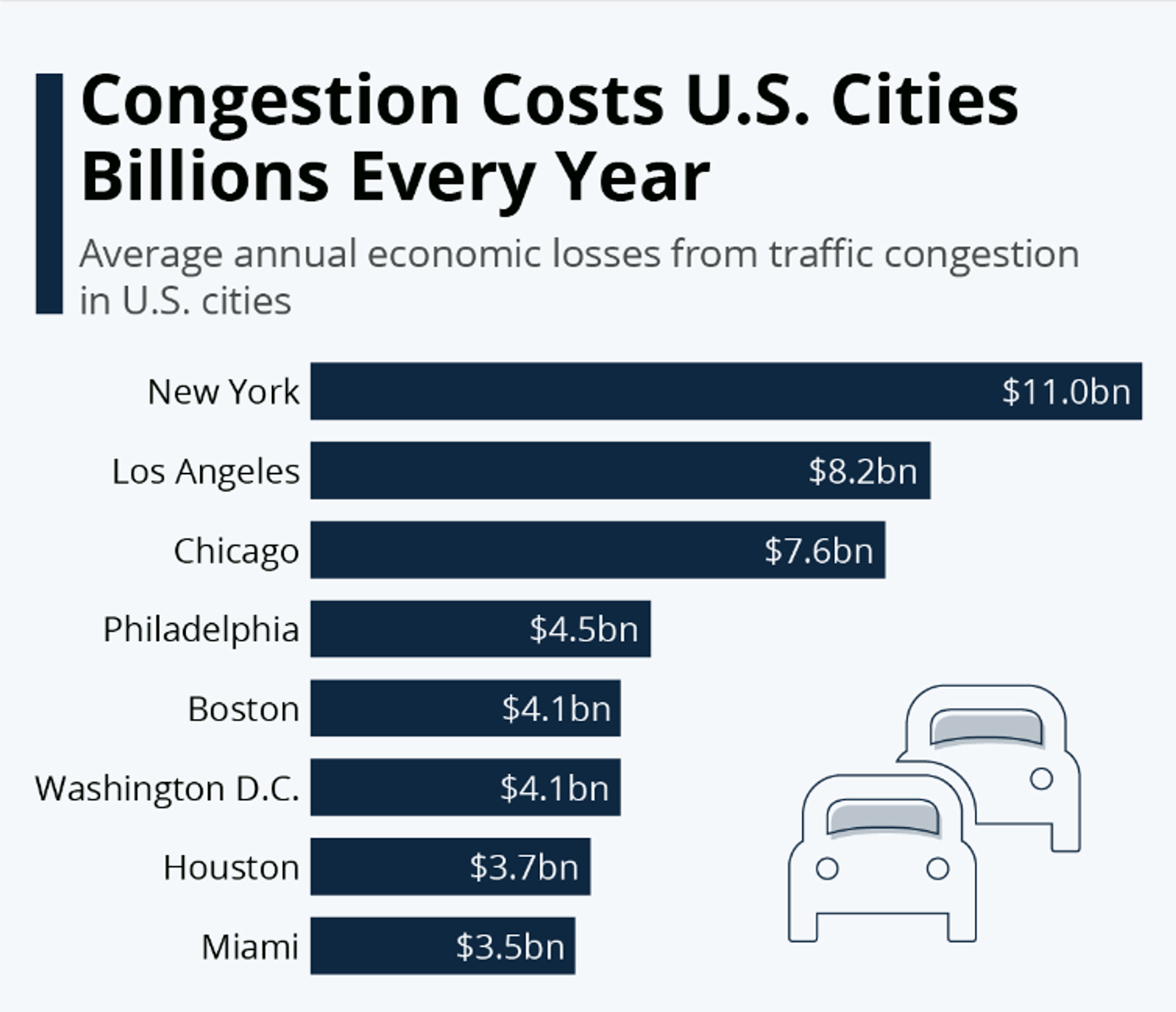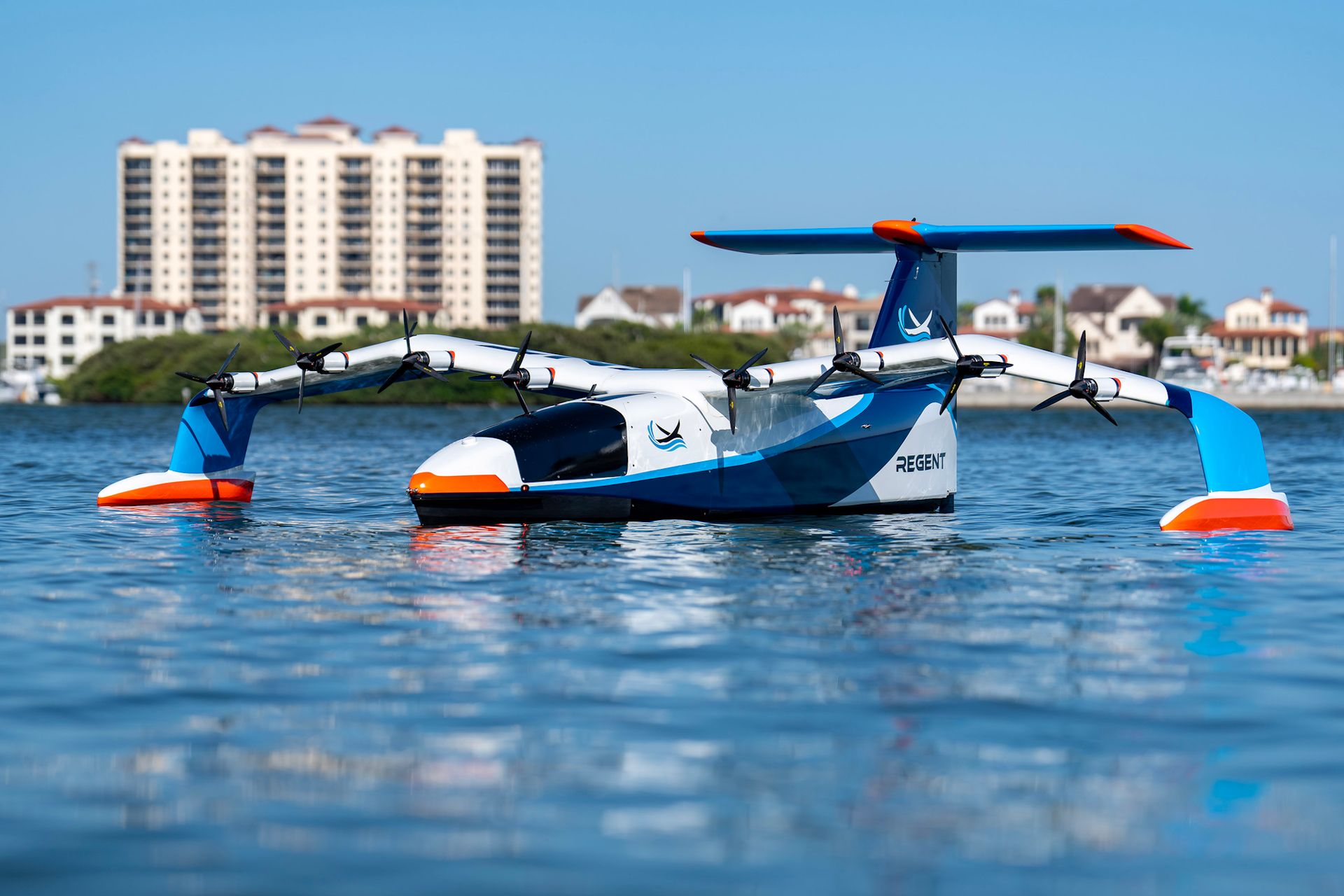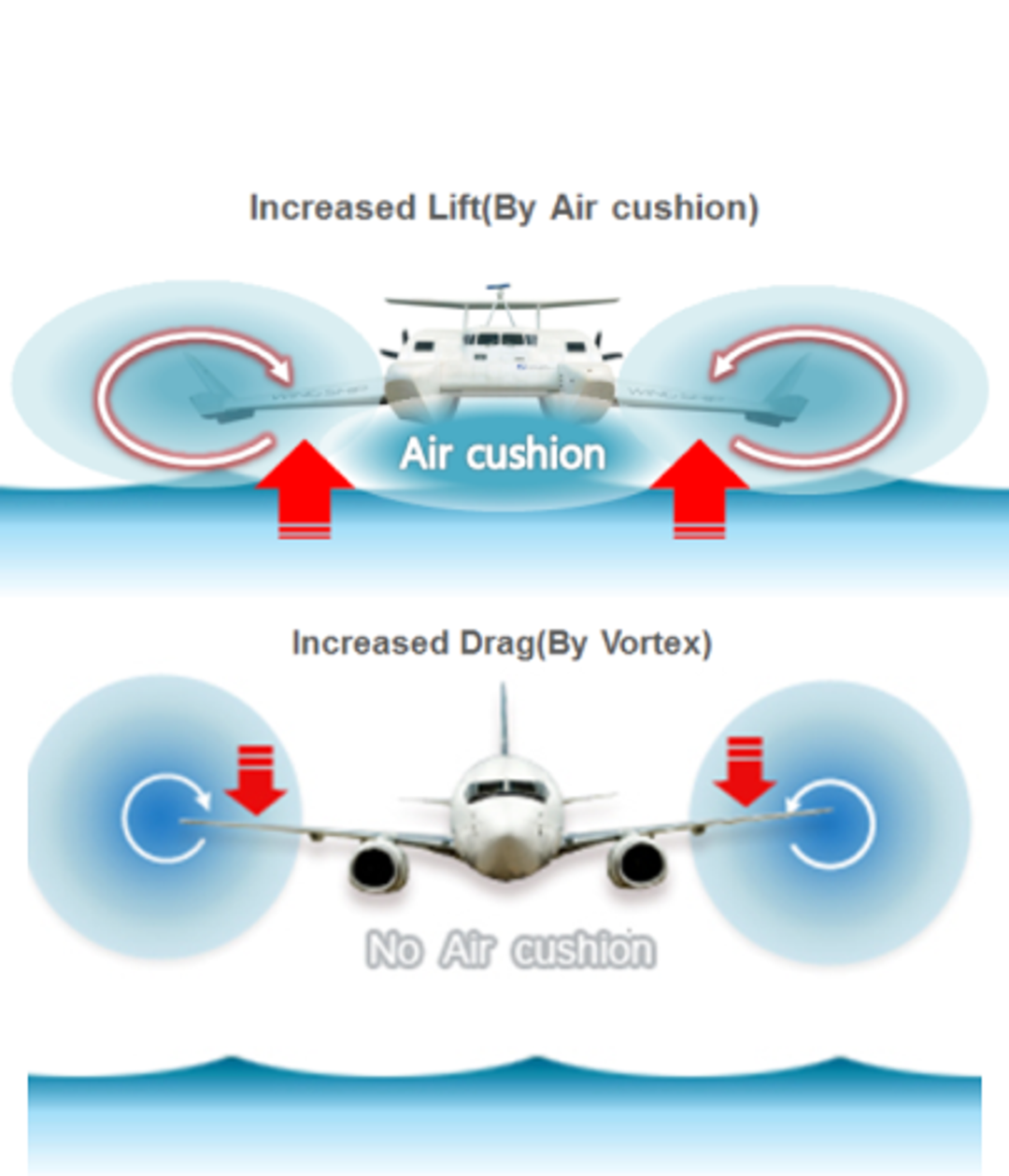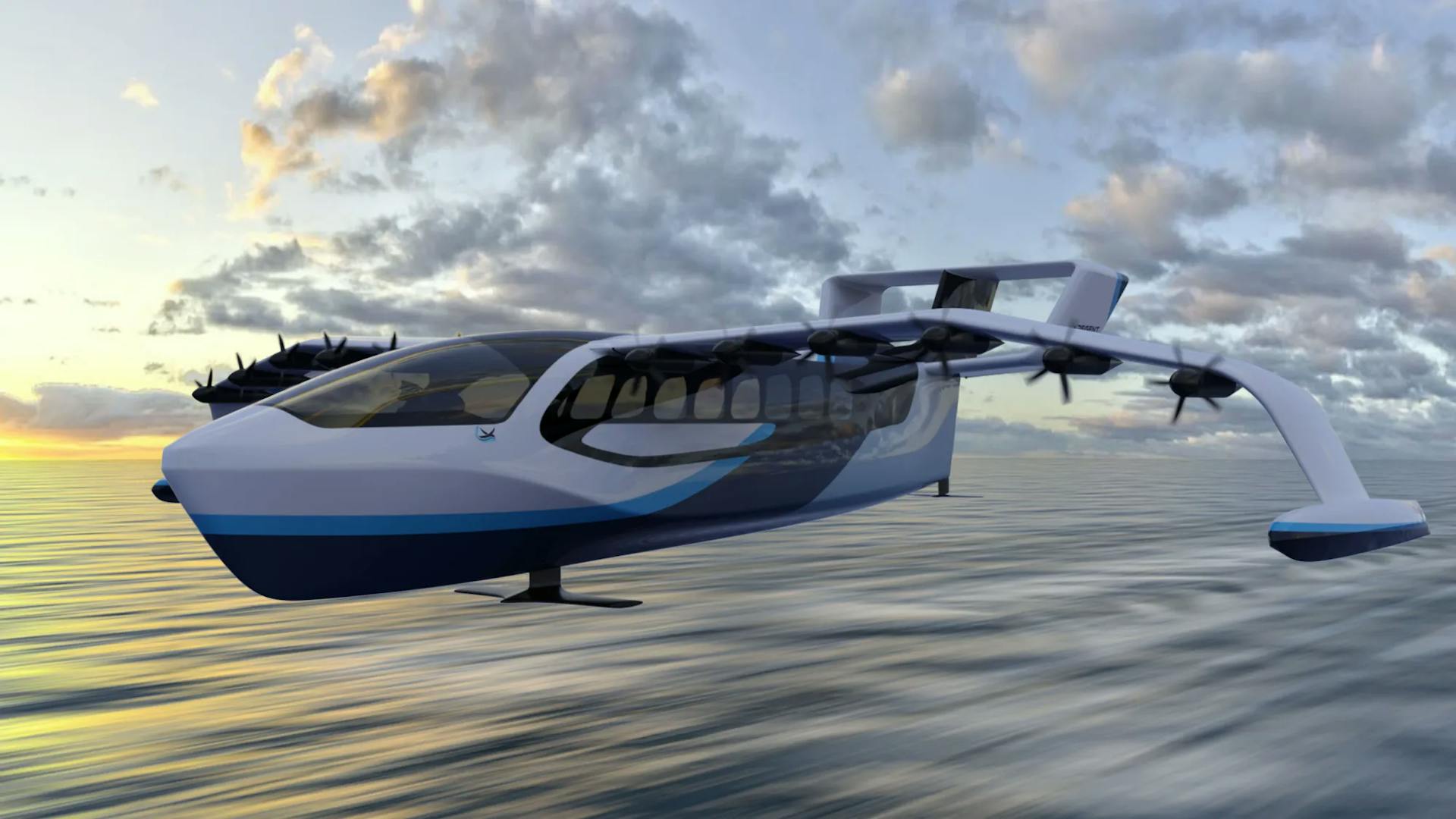Why you should join Regent
Introduction
If you’re the average American commuter, you’ll spend nearly 250 hours each year in transit.
That’s a little over 10 days, or 4% of your waking hours.
Add it up over the span of your working life, and the average American spends well over a year going to and from the office.

To get around this national crisis, America’s more innovative commuters have begun turning to other modes of transport. For instance, there's been a noticeable rise in ferry usage: this past year, San Francisco reported a nearly 11% increase from the year prior. Others have taken to the skies: remember Kylie Jenner’s 17-minute flight across LA?
Unfortunately for most of us, these solutions aren’t particularly attainable. A few things are holding us back:
- - Cost. Alternative forms of transport are often more expensive to operate. For instance, the maintenance and fuel costs for private jets are significantly higher than those of cars or public buses.
- - Infrastructure. Scaling up alternative transportation methods like ferries and air travel means expensive infrastructure like docks and airports, which are costly and space-intensive. Additionally, their development can face challenges due to urban planning limitations, environmental issues, and community resistance.
- - Emissions. Alternative transportation methods like ferries and private flights, along with their infrastructure, contribute significantly to greenhouse gas emissions, posing greater environmental challenges than traditional forms of public transport options.
Background
Our cities have gotten significantly more congested over the last two decades, but the scalability of our infrastructure hasn’t kept up.
This has led to strain that’s far more than just an inconvenience: all this gridlock means lost time, wasted fuel, and heightened costs of doing business that drains between 2 to 4 percent of national GDP each year. The total cost of traffic associated with just lost time and wasted fuel alone exceeds $100 billion per year.

Worse, all this congestion creates enormous amounts of greenhouse gas emissions, something which has a huge impact on public health: in 2014, the WHO estimated that seven million premature deaths annually are attributable to air pollution from urban transit.
With so much on the line, it’s clear that the world needs a fundamentally new form of alternative transportation. Ideally, this method would have both:
- 1. Minimal infrastructure requirements
Traditional alternative transport modes like planes and ferries exacerbate congestion problems. Airports demand substantial space in already crowded cities, and railways require thousands of miles of high speed rail track, adding to infrastructural strain.
Not to mention, they’re expensive.
Take the Van Ness Bus Rapid Transit lines project. The San Francisco bus lane project, which has been in operation for 16 months now, cost the city over $300 million ($35 million over budget) and finished three years behind schedule. - 2. Reduced greenhouse gas emissions
Alternatives shouldn’t further exacerbate our climate’s problems. Unfortunately, the ones we have do. Airplanes, for example, emit about 100 times more carbon per hour than a shared bus or train ride. Ferries aren’t great also, generating significantly greater emissions per passenger per kilometre compared to driving a car the whole way.
Enter: Regent
Founder-CEO Billy Thalheimer has a solution to the problem above.
A seaglider.
Yep, you heard that correctly.
Creating seagliders isn't an everyday ambition, but Billy isn’t an everyday engineer. After graduating from MIT, he carved out an impressive career in the commercial world, focusing on advanced aircraft design at Blue Origin and Virgin Galactic before moving to Aurora Flight Science, later acquired by Boeing to develop electric aircraft.
While leading the flight physics team for the Boeing PAV electric air taxi, Billy recognized the significant challenges that still existed in electrifying aircraft:
- 1. Limited range, primarily stemming from the current state of battery technology, the inevitable aging of batteries, and the essential requirement for reserve fuel.
- 2. The cost and duration of the aviation certification process, which would take over a decade and cost approximately a billion dollars.
At the same time, he began to realize their significant promise.
Electric aircraft were more sustainable, had lower fuel costs, lower maintenance costs, and lower noise levels than their fuel-powered counterparts.
Billy's determination to realize the potential of electric aircraft propelled him to make a pivotal career move. He left his high-flying position at Boeing and founded Regent, where he was joined by his MIT classmate and Aurora teammate Mike Klinker.
Together, the two began building electric seagliders — their solution for the gap in the market.

Regent's seagliders leverage the unique properties of electric aircraft to solve both of the issues above. They reduce most of the greenhouse gas emissions from short-haul flights in aviation, ferries, and water taxis, while working perfectly with existing infrastructure. They don’t require runways or taxiways, instead using adjacent waterways for takeoff, landing, and docking.

It’s a harmonious enhancement to the existing array of maritime and air travel options, allowing them to integrate seamlessly with existing fleets.
Let’s take a closer look at this unique machine.
The Product
Regent is developing a seaglider, a type of craft designed to fly just meters above the water surface. By flying close to a solid surface, Regent's seaglider leverages the wing-in-ground-effect to significantly increase lift and decrease aerodynamic drag. This allows the craft to operate efficiently, maintaining high performance with less energy expenditure.

This innovative vehicle combines the high-speed capabilities of an airplane with the economic efficiency of a boat. These seagliders will initially transport 12 passengers, with plans for larger models accommodating 50 or more.

Cruising at 180 miles per hour (156 knots), these seagliders promise significantly reduced travel times compared to traditional surface and maritime transportation methods. For coastline communities, they’re well-positioned to replace things like trains, ferries, and commuter airlines.
Beyond civilian use, Regent’s seagliders are also being considered for a number of military applications. The U.S. Department of Defense has already recognized their potential for high-speed, cost-effective, and runway-independent mobility in coastal regions. These applications might include things like transporting cargo, logistics resupply missions, and search and rescue missions.
A significant milestone for this was Regent’s completion of the world's first all-electric seaglider flight last September. This achievement demonstrated the seaglider's versatility across three maritime operational modes: floating, foiling, and flying. This integration of floating, foiling, and flying is key to understanding how Regent's seaglider operates as a fully functional maritime vehicle, adept in diverse water environments. Seagliders navigate waterways using two intermediary modes: floating and foiling. They float on their hull at docks and in "no wake zones," or areas with low speed limits. Foiling allows them to maneuver through waves up to 1.5 meters and reach higher speeds needed for takeoff. Flight occurs over open water, away from high-traffic areas and outside of the inner harbor.
With the national security focus shifting towards the Indo-Pacific, particularly the South China Sea and the broader China Pacific area, the strategic potential of these seagliders has become particularly pronounced.
This region is characterized by island chains stretching across thousands of miles, a setting that poses significant logistical challenges to sustaining supply and troop lines. Regent's ease of operation, relatively low cost, reduced visibility, low noise, and ability to dock anywhere are particularly valuable in this context.
Traction
Several airlines and ferry companies like Mesa Airlines, Brittany Ferries, and FRS have entered agreements to buy Regent's seagliders. Regent has already secured orders for over 500 of their craft, which translates to approximately $8 billion in potential revenue. Southern Airways is set to receive Regent’s first production model. It’ll be used under their Mokulele Airlines brand, which flies inter-island routes in Hawaii.
In addition, Regent has proven quite popular with investors. The company has secured over $90 million in funding from the likes of 8090 Industries and Founders Fund, who jointly spearheaded the Series A round. Regent is also backed by funds like Point72, Caffeinated Capital, and Future Planet Capital, as well as notable angel investors like Mark Cuban. A number of strategic partners like Yamato Holdings (Japan's largest logistics firm), Japan Airlines Innovation Fund, and Lockheed Martin have also made significant strategic investments
Business Model
The primary customers for these seagliders include airlines, ferry companies, and the Department of Defense.
Airlines plan on using Regent's craft for short-to-medium flight routes, Ferry companies plan on using them since they’re cheaper than ferries, and the military wants to use them for their unique logistical capabilities.
Market Sizing
Given the unique nature of seagliders, directly estimating their market size poses a challenge. Instead, we can consider the various markets they’d sell into as proxies.
- 1. Ferries
This sector contributes about $60 billion annually to the global GDP . The electrification and increased efficiency offered by seagliders could revolutionize this market, suggesting a substantial portion of this sector could transition to seaglider technology. - 2. North American Rail Infrastructure
Projected to grow from $119.43 billion in 2022 to $162.72 billion by 2029 at a CAGR of 4.52%, this market shows significant demand for more efficient and more sustainable transport solutions. Seagliders could play a role in this transition, particularly in coastal and riverine areas. - 3. The cost and duration
The total addressable market for small regional flights globally is estimated to reach $75 billion to $115 billion by 2035, accounting for 300 to 700 million passengers annually. Seagliders could capture a portion of this market, especially for routes over water or in areas lacking airport infrastructure.
This isn’t including Regent's wildcard: the Department of Defense.
Earlier this year, the Pentagon released its budget request for Fiscal Year 2024. The number is set at $886 billion and after Congressional allocations, this number could escalate to over $950 billion. If so, this would mark the highest military budget since World War II, surpassing peak military spend during the Korean War, the Vietnam War, and the Cold War.
A sizable portion of this budget will go towards the strategically important South China Sea. This region, where about a third of the world's maritime trade passes through and half of the oil and gas tankers from the Middle East use, is of paramount importance to the United States. With seacraft offering unique capabilities in this theatre, it’s reasonable to expect some of that spend will go towards companies like Regent also.
Working at Regent
Introducing a new mode of transportation requires more than just innovative ideas; it requires a team with exceptional talent and experience.
Regent has just such a team. Consider a sampling of their roster:
Billy Thalheimer, Co-founder and CEO
- Billy co-founded Regent after years spent as an aerospace program manager, business development leader, and multidisciplinary aerospace engineer at various aerospace firms. He graduated from MIT with a BS and MS in Aeronautical Engineering.
Michael Klinker, Co-founder and CTO
- Before co-founding Regent, Michael spent years as an engineering leader at a variety of innovative aerospace firms and MIT aersopace laboratories. He also graduated with an MS and BS in Aeronautical Engineering from MIT.
Jon Guidoboni, Director of Manufacturing
- Jon was previously Director of Engineering at Xwing, an autonomous aviation startup. He worked in Strategy and Corporate Development at Blue Origin and was an Engineering Manager at SpaceX. Jon holds a BS in Mechanical Engineering from The George Washington University, an MS in Mechanical and Aerospace Engineering from Harvard University, and an MBA from Harvard Business School.
Daniel Cottrell, VP of Engineering
- Daniel was previously Propulsion and I&T Lead for various Aurora eVTOL projects at Aurora Flight Sciences Corporation, where he spent 13 years. He earned his BS in Aerospace, Aeronautical and Astronautical Engineering from the University of Maryland.
Sam Carp, Senior Flight Software Engineer
- Sam was previously a Senior Research Engineer at Scientific Systems and a System Engineer at Lockheed Martin. He worked as a Research Assistant at the University of Pennsylvania and as a Junior Quantitative Analyst at Bluefin Trading LLC.
One of Regent's core values, “Every day is a tryout,” sets the tone for its culture. This philosophy underpins a work environment where passion is a prerequisite and excellence is the norm.
The team of 60 has a remarkably diverse array of expertise. Regent's naval engineers have contributed to winning designs for the America’s Cup, their aerospace engineers have designed airplanes at Boeing, and their software engineers previously built simulations at SpaceX. These experts are now working together to build the hull, wings, and software powering Regent's seaglider.
The company is based in Rhode Island, an unconventional location for a high-tech startup, yet a region with a deeply rooted maritime industry. Similar to the local shipbuilding culture, Regent places a strong emphasis on in-person collaboration. Employees come together in a hands-on environment, working to develop a new mode of transportation
Key Risks & Opportunities
Regent is offering an entirely new way to travel. This offers an endless array of opportunities in cargo, commuting, and even defense.
At the same time, there are several risks worth considering:
Novel Hardware
Developing novel hardware like Regent's presents significant challenges. There are high development and production costs, manufacturing challenges, and lots of untested technologies to deal with. Getting a team with all the specialized skills needed to put everything together isn’t easy either.
Regulatory Hurdles
The biggest regulatory hurdle to overcome is obtaining certification under maritime law, a process that can take several years. The first of Regent's vehicles is subject to regulation by the U.S. Coast Guard, which means compliance with a set of standards around design and construction processes.
Adoption Challenges
Replacing current fleets with this new technology isn’t straightforward. It involves logistical challenges, significant financial investment, navigating bureaucracy, and convincing stakeholders of the novel benefits of seagliders.
Conclusion
Imagine living in San Jose and being able to commute to San Francisco in just 15 minutes.
Today, that same trek can take up to two hours during peak traffic.
Seagliders promise a future where travel isn’t just faster and more convenient, but also environmentally responsible and harmonious with existing infrastructure.
Regent is growing fast and hiring tons of roles including a Electrical and Avionics Engineer, Flights Control Engineer, Mechanical Engineer and Head of Supply Chain just to name a few.